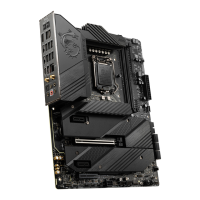
Do you have a question about the MSI MEG Z590 UNIFY-X and is the answer not in the manual?
| Non-ECC | Yes |
|---|---|
| Memory channels | Dual-channel |
| Memory slots type | DIMM |
| Number of memory slots | 2 |
| Supported memory types | DDR4-SDRAM |
| Maximum internal memory | 64 GB |
| Supported memory clock speeds | 2133, 2400, 2666, 2933, 3000, 3200, 3300, 3333, 3400, 3466, 3600, 3733, 3866, 4000, 4133, 4200, 4266, 4300, 4400, 4533, 4600, 4800, 5000, 5333, 5600 MHz |
| Processor socket | LGA 1200 (Socket H5) |
| Processor manufacturer | Intel |
| Compatible processor series | Intel® Core™ i9 |
| RAID levels | 0, 1, 5, 10 |
| Number of storage drives supported | 4 |
| Supported storage drive interfaces | M.2, PCI Express 3.0, PCI Express 4.0, SATA III |
| Parallel processing technology support | CrossFire |
| Number of SATA III connectors | 6 |
| USB 3.2 Gen 1 (3.1 Gen 1) connectors | 1 |
| USB 2.0 ports quantity | USB 2.0 ports have a data transmission speed of 480 Mbps, and are backwards compatible with USB 1.1 ports. You can connect all kinds of peripheral devices to them. |
| USB 3.2 Gen 1 (3.1 Gen 1) Type-A ports quantity | 8 |
| USB 3.2 Gen 2 (3.1 Gen 2) Type-C ports quantity | 0 |
| LAN controller | Intel I225-V |
| Bluetooth version | 5.2 |
| Top Wi-Fi standard | Wi-Fi 6E (802.11ax) |
| WLAN controller model | Intel Wi-Fi 6E AX210 |
| Ethernet interface type | 2.5 Gigabit Ethernet |
| Audio chip | Realtek ALC4080 |
| Component for | PC |
| Motherboard chipset | Intel Z590 |
| Audio output channels | 7.1 channels |
| Motherboard form factor | ATX |
| Number of mounting holes | 9 |
| Windows operating systems supported | Windows 10 |
| BIOS type | - |
| Cables included | SATA |
| Depth | 244 mm |
|---|---|
| Width | 305 mm |
Lists necessary tools and components, along with initial safety precautions for computer assembly.
Step-by-step instructions for installing the CPU and DDR4 memory modules onto the motherboard.
Guides on how to properly install the motherboard into the chassis and connect power supply connectors.
Instructions for installing SATA drives and the graphics card into the system.
Steps to connect the system to power and turn it on for the first time.
Technical specifications for the CPU socket, chipset, and supported DDR4 memory.
Details on PCIe expansion slots and onboard graphics capabilities.
Information on SATA ports, M.2 slots, and supported RAID configurations.
Specifications for USB ports, audio codecs, LAN controller, and wireless connectivity.
Details on internal connectors, jumpers, LEDs, and buttons on the motherboard.
Overview of rear I/O panel ports, hardware monitoring, and BIOS features.
Information on cooling, protection, LED control, performance features, and CORSAIR integration.
Detailed layout of the rear I/O panel, including ports, buttons, and LED status.
Explanation of audio jack configurations and the Realtek Audio Console software.
Instructions for correctly installing the Wi-Fi antennas for optimal signal reception.
Description of the CPU socket, DIMM slots for memory, and PCIe expansion slots.
Details on M.2 slots and SATA connectors for storage device installation.
Information on power connectors, fan headers, RGB connectors, and front panel headers.
Explanation of onboard LEDs for system status and debug code meanings.
Guide for installing the operating system and necessary hardware drivers.
Overview of the MSI Center application for system optimization and control.
Instructions on how to enter the BIOS setup and navigate its interface.
Procedures for resetting BIOS to default settings and updating the BIOS.
Configuration options for audio effects, profiles, and volume control in Nahimic 3.
Settings for microphone effects, profiles, and noise suppression in Nahimic 3.
Explanation of the Sound Tracker feature for in-game audio visualization.
Guidance on resolving issues related to the system not powering on or displaying a signal.
Troubleshooting steps for common problems with audio, network, and USB devices.
FCC, CE, and other regional compliance and safety statements.
Information regarding environmental protection, battery disposal, and WEEE directives.
Restrictions and guidelines for using wireless radio frequencies.
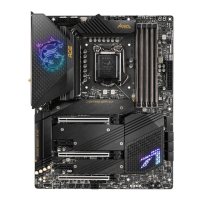

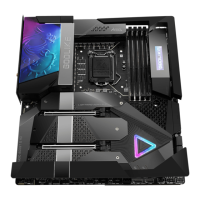



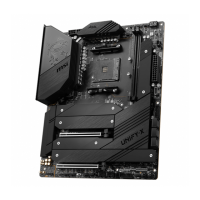


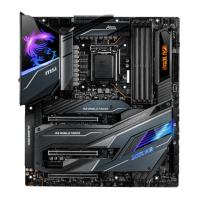

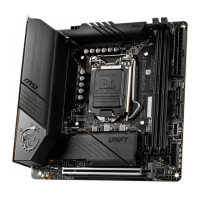
